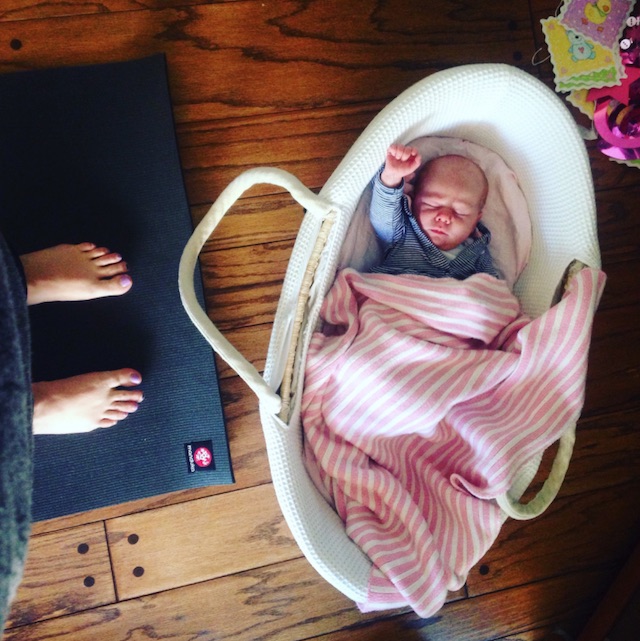
The first time I did a downward dog after birthing my daughter, Bella, it was like stepping onto the mat for the very first time.
Everything was so foreign. And yet it was totally different from the first time, because I had never felt such tightness before.
My body had always been flexible and relaxed, but this downward dog made me intimately aware of all that my body had just been through with pregnancy and birth.
I couldn’t even get my arms to bind in eagle pose, my chest and shoulders were so tight.
But child’s pose, oh child’s pose! It had never felt quite so good.
I am incredibly grateful for my practice, because it was there for me. It didn’t care how tight or tired I was, or how little I cared to move in the beginning.
It was happy to have me simply move through cat/cow, paying attention to my breath, or spend five minutes in a restorative pose before going to sleep.
There’s such beauty in simplicity. And after we first give birth, that’s what we need.
All of this brings me to my main point, the five tips I’d like to offer to new moms getting back into (or just starting!) their yoga practice:
1) Non-Attachment.
Vairagya, non-attachment, is one of the core principles of yoga.
Every time we step onto the mat, we are to come with a beginner’s mind. We should be completely open to new experiences and without expectation of what will come up for us, or how our practice will look or feel.
It’s both easiest and hardest to practice this mentality after giving birth (or while pregnant). Everything feels different all the time, so it makes sense to simply go with the flow and recognize that. On the other hand, it’s scary feeling so foreign in your own skin.
My best advice? Don’t be attached to the way the poses feel, the poses you are able to do, how often you do them, or how your new body feels.
This could take up another article in itself, but one of my yogi friends told me “don’t be attached to losing the baby weight” either. The more I attached to the thought of losing weight, the more that weight would attach to me.
So whether you get two minutes for a practice or an hour, enjoy that you are breathing and taking sacred time to honor your body in the ways it needs.
2) Practice lots of chest-openers.
Having a new baby means lots of hunching forward. Picking them up, holding them, nursing them.
It’s such a beautiful, protective stance to hold your baby nestled into your heart.
But it wrecks havoc on the shoulders, spine, low back, and yes, chest! I even started hunching so far forward when I was sleeping with my baby that my jaw jutted forward and I started having teeth problems.
Reclining back on a yoga bolster (or firm cushion) with your arms open to the sides, palms face up is a wonderful place to start.
You can also stand against a wall with your tailbone, shoulder blades, and head touching the wall, low back slightly arched. Place your arms against the wall with elbows bent, in line with your shoulders, and hands pointing up toward the sky, like a cactus. Move your elbows up and down (never lower than your shoulders) and feel how much this opens the chest and encourages good posture!
3) Engage your pelvic floor while your hips are inverted.
Mula bandha, kegels, whatever you do to practice pelvic floor strength, do it while your hips are lifted!
This is a beautiful and impactful tip I learned from a women’s health physical therapist.
A strong pelvic floor is essential to good core strength, eliminating incontinence, and recovering from pregnancy and birth. It’s important to rebuild that strength now, rather than recognizing it is a problem 10 years later and realizing you need to wear adult diapers—or so the story goes from a few grandmas who got way too personal and told me this happened to some of their friends.
After I had my daughter, I felt so out of touch with those muscles, like there wasn’t anything even happening when I tried to engage them. I was amazed, though, at how quickly they regained their strength! Especially if I practiced strengthening them in bridge pose, downward dog, or with a pillow under my hips in legs-up-the-wall.
4) Practice three-part breathing.
Dirga pranayam, or three-part breathing, is a simple way to nourish and heal yourself. It expands the chest (see point number two), gently detoxifies, and helps create a calm and peaceful state.
The best part about this is it can be done anywhere, any time. Practice while feeding your baby, laying in bed, or stepping outside to take a moment for yourself.
The best way I like to describe it is to breathe like you are filling up a glass of water, the glass being your entire torso.
Breathe into your belly…into your ribs…into your chest. Pause. Then exhale like you are pouring it back out again. Exhale the chest…ribs…belly. Emptiness. Repeat.
Bonus points if you practice engaging your pelvic floor during the pause at the top of the breath!
4) Get your baby involved in your practice!
Place them face up beneath you while you do cat/cow or downward dog. Make funny faces at them. Bend down to give them kisses. Hear them giggle as you move and breathe.
Show them what it is to be active and healthy, enjoying your body and breath.
Eventually, you can incorporate them into your practice even more. Doing poses just for them is a great way to bond together and encourage a healthy lifestyle.
You can find a Mommy & Me style class or grab a couple of books to help show you the way. My favorites are Itsy Bitsy Yoga by Helen Garabedian or Baby Om by Laura Staton.
That’s it! Have fun, trust your body, trust your baby, trust your practice. Be patient. Remember, your baby chose you for a reason—you are the perfect mom for them.
Namaste, mama!
Author: Jessica Cartwright
Image: Author’s Own
Editor: Emily Bartran










Read 0 comments and reply